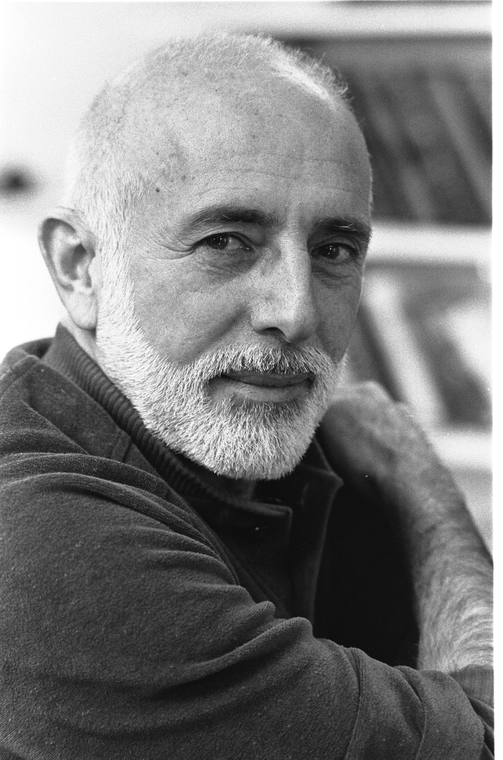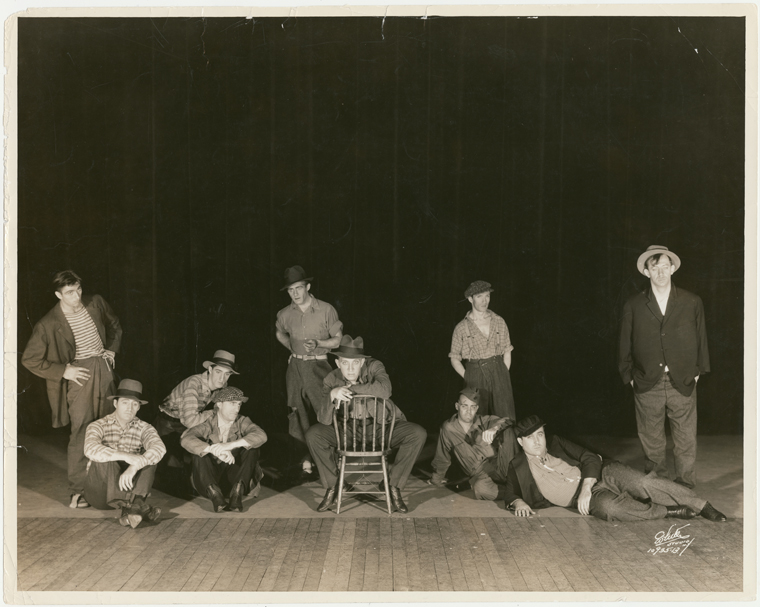Cunningham and Television in the Sixties by Claire Bishop
by Kathleen Leary, Dance Education Coordinator, Jerome Robbins Dance Division, New York Public Library for the Performing Arts, Dorothy and Lewis B. Cullman Center
January 18, 2019
While researching the work of Merce Cunningham, author and professor Claire Bishop discovered Cunningham's openness to new technology and keen interest in television, and the connection drawn between TV spectatorship and the decentralization of stage space.
A Dancer's Life, Shaped by Jerome Robbins by Ellen Bar
by Kathleen Leary, Dance Education Coordinator, Jerome Robbins Dance Division, New York Public Library for the Performing Arts, Dorothy and Lewis B. Cullman Center
November 27, 2018
Former New York City Ballet dancer Ellen Bar recalls seeing her first Robbins ballet, bringing one to film, and then sharing dance with her young daughter.
Geography Lessons by Amanda Vaill
by Kathleen Leary, Dance Education Coordinator, Jerome Robbins Dance Division, New York Public Library for the Performing Arts, Dorothy and Lewis B. Cullman Center
October 4, 2018
In anticipation of her upcoming book, "The World Opened Up: Selected Writings of Jerome Robbins," the bestselling author details her look into Robbins' life and work.
Jerome Robbins at 100, and After, by Julia Foulkes
by Kathleen Leary, Dance Education Coordinator, Jerome Robbins Dance Division, New York Public Library for the Performing Arts, Dorothy and Lewis B. Cullman Center
September 7, 2018
Hear from the curator of the upcoming exhibit, "Voice of My City: Jerome Robbins and New York," on how she addressed the life of a brilliant and complicated artist.
Using Visual Thinking Strategies in Dance Curriculum by Julie Lemberger
by Kathleen Leary, Dance Education Coordinator, Jerome Robbins Dance Division, New York Public Library for the Performing Arts, Dorothy and Lewis B. Cullman Center
August 2, 2018
A 2017-2018 Jerome Robbins Dance Research Fellow shares her experiences merging photography and dance to a group of third graders.
Awakening of Humanity Within the Framework of Classicism by Adrian Danchig-Waring
by Kathleen Leary, Dance Education Coordinator, Jerome Robbins Dance Division, New York Public Library for the Performing Arts, Dorothy and Lewis B. Cullman Center
July 30, 2018
Adrian Danchig-Waring, principal dancer for the New York City Ballet and a 2017-2018 Jerome Robbins Dance Research Fellow, discusses Robbins, Balanchine, and philosophies of ballet.
Robbins in Love With Chopin: "No Stories" By Robert Greskovic
by Kathleen Leary, Dance Education Coordinator, Jerome Robbins Dance Division, New York Public Library for the Performing Arts, Dorothy and Lewis B. Cullman Center
May 14, 2018
49 years later, Robert Greskovic remembers the premiere of the ballet Dances at a Gathering—and the intricate details of its construction which lend to its timelessness.
Jerome Robbins On Television by Gregory Victor
by Kathleen Leary, Dance Education Coordinator, Jerome Robbins Dance Division, New York Public Library for the Performing Arts, Dorothy and Lewis B. Cullman Center
April 13, 2018
Editor-in-Chief of the Jerome Robbins Foundation newsletter Gregory Victor has spent many years writing in specific detail about under-reported areas of Robbins' life and career. In this guest blog, he writes about Robbins' relationship with television. Robbins studied the medium technically, not passively in his role as audience, and gave much thought to its capacity and its limitations as producer.
Director/choreographer Jerome Robbins resisted working in television. Robbins had three main objections: the challenge in collapsing three-dimensional
Fond Reminiscences of Jerome Robbins by William James Earle
by Kathleen Leary, Dance Education Coordinator, Jerome Robbins Dance Division, New York Public Library for the Performing Arts, Dorothy and Lewis B. Cullman Center
March 8, 2018
A good friend and frequent dinner guest of Jerome Robbins shares his thoughts on the world-famous choreographer's friends and good times (and love of the NYPL), in this guest post.
An Emotional Archive: Hiie Saumaa on Jerome Robbins
by Kathleen Leary, Dance Education Coordinator, Jerome Robbins Dance Division, New York Public Library for the Performing Arts, Dorothy and Lewis B. Cullman Center
February 14, 2018
A Jerome Robbins Dance Research Fellow reflects on Robbins' life and archives, from a January 2018 symposium.
Finding Frederick Melton
by Stephen Bowie, Digital Curatorial Assistant, New York Public Library for the Performing Arts, Dorothy and Lewis B. Cullman Center
January 26, 2018
To promote an exhibition on George Balanchine's 'The Nutcracker', an NYPL staff member had to become a detective. Here's the fascinating story.
Connected Choreography? Nijinsky's "Faune" & Robbins's "Faun"
by Kathleen Leary, Dance Education Coordinator, Jerome Robbins Dance Division, New York Public Library for the Performing Arts, Dorothy and Lewis B. Cullman Center
January 5, 2018
Alastair Macaulay, chief dance critic for The New York Times, investigates connections between Vaslav Nijinsky’s "L'Après-midi d'un Faune" and Jerome Robbins’s "Afternoon of a Faun."
Sharing Dance Digitally: Understanding Issues of Copyright & Access
by Kathleen Leary, Dance Education Coordinator, Jerome Robbins Dance Division, New York Public Library for the Performing Arts, Dorothy and Lewis B. Cullman Center
December 12, 2017
Intern Lexa Armstrong shares what she learned while working in the Jerome Robbins Dance Division.
Digital Footprints: Creating a Loie Fuller Database
by Kathleen Leary, Dance Education Coordinator, Jerome Robbins Dance Division, New York Public Library for the Performing Arts, Dorothy and Lewis B. Cullman Center
December 4, 2017
Intern Juliana DeVaan shares what she learned while working in the Jerome Robbins Dance Division.
Isadora Duncan and Her Collaborators
by Arlene Yu, Jerome Robbins Dance Division, New York Public Library for the Performing Arts, Dorothy and Lewis B. Cullman Center
May 1, 2017
Guest post by New York Public Library Short-Term Fellow Chantal Frankenbach, California State University, Sacramento
The American modern dancer Isadora Duncan (1877–1927) was one of the most acclaimed and influential artists of her time. Notorious for her romantic involvements with the likes of British theater critic Gordon Craig, German biologist Ernst Haeckel, and millionaire Paris Singer, Duncan also attracted artists and intellectuals as collaborators in her work as a dancer. These collaborations have a great deal to tell us of her wide-ranging ideas about the
Bugaku: Japanese Imperial Court Dance
by Arlene Yu, Jerome Robbins Dance Division, New York Public Library for the Performing Arts, Dorothy and Lewis B. Cullman Center
April 6, 2017
For much of its history, bugaku remained an exclusive and privileged experience, performed only at the Japanese imperial court and, very rarely, as part of religious rituals at temples or shrines.
African Dance Interview Project Year Two Videos Now Available
by Daisy Pommer
January 30, 2017
The Jerome Robbins Dance Division is pleased to belatedly announce that the final seven interviews documented with the Mertz Gilmore Foundation grant to record African dancers and choreographers working and teaching in New York are now online
Macabre Imagery: Visual Representations of the Dance of Death
by Arlene Yu, Jerome Robbins Dance Division, New York Public Library for the Performing Arts, Dorothy and Lewis B. Cullman Center
October 28, 2016
A new case exhibit on the third floor of the Library for the Performing Arts presents a small historical survey of the characteristic imagery and common features of visual representations of the dance of death.
The 50th Anniversary of 9 Evenings: Theatre and Engineering and Experiments in Art and Technology, Incorporated (E.A.T.)
by Arlene Yu, Jerome Robbins Dance Division, New York Public Library for the Performing Arts, Dorothy and Lewis B. Cullman Center
October 26, 2016
In celebration of its anniversary, a current case exhibit on the third floor of The New York Public Library for the Performing Arts highlights materials related to 9 Evenings.
"Brother, Can You Spare a Dime"
by Barbara Cohen-Stratyner
October 11, 2016
A look at the White Studio photograph from the 1932 edition of the revue Americana.
 With your library card, it's easier than ever to choose from more than 300,000 e-books on SimplyE, The New York Public Library's free e-reader app. Gain access to digital resources for all ages, including e-books, audiobooks, databases, and more.
With your library card, it's easier than ever to choose from more than 300,000 e-books on SimplyE, The New York Public Library's free e-reader app. Gain access to digital resources for all ages, including e-books, audiobooks, databases, and more.
















